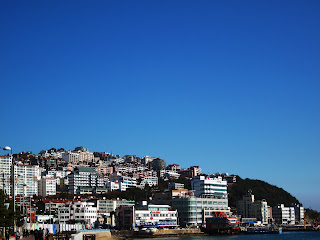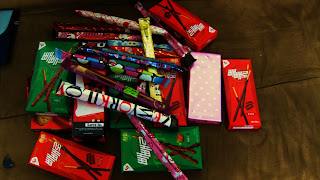Was midway through writing the latest blog when the television was switched on for the second time in the past week. I could only wonder what the latest news might be - had Korea had another Kimchi shortage? Perhaps they had beaten China or Japan in another minor sporting event or was it the neighours from the North causing trouble again?
http://www.bbc.co.uk/news/world-asia-pacific-11818005
From the images I saw on the television it is quite clear that it is the latter of the three and to be honest burning houses is never a good sign - particularly when they are caused by a bordering country who have a long running dispute.
http://www.nytimes.com/aponline/2010/11/23/world/asia/AP-AS-Koreas-Tension.html?_r=2
'Illegal firing'
South Korean officials said artillery rounds landed on Yeonpyeong island, near the disputed inter-Korean maritime border to the west of the Korean Peninsula.
"A North Korean artillery unit staged an illegal firing provocation at 1434 PM (0534 GMT) and South Korean troops fired back immediately in self-defence," a defence ministry spokesman told AFP.
A resident on the island told the agency that dozens of houses were damaged, while television pictures reportedly showed plumes of smoke rising above the island.
"Houses and mountains are on fire and people are evacuating. You can't see very well because of plumes of smoke," a witness on the island told YTN television station.
"People are frightened to death and shelling continues as we speak," the witness said.
South Korea had deployed fighter jets to the island, Yonhap news agency said.
http://www.telegraph.co.uk/news/worldnews/asia/southkorea/8153000/North-Korea-bombs-South-Korean-island.html
North Korea's conflict with the South: timeline
North and South Korea have been involved in a number of skirmishes since the 1950-1953 war, which ended in an armistice rather than a formal peace treaty:
January 21, 1968: North Korean commandos stage a raid on Seoul's presidential Blue House in an attempt to assassinate President Park Chung-Hee. They are stopped just 800 metres (yards) away. All 32 are killed or captured in subsequent days.
August 15, 1974: North Korean agent fires at Park during a speech. He misses but the shot kills the president's wife. Park continues his speech.
October 9, 1983: The North's agents blow up a landmark in Burma (now Myanmar) just before the visiting South Korean President Chun Hoo-Hwan is set to arrive. Four South Korean cabinet ministers and 16 others are killed.
November 29, 1987: All 115 people on board are killed when a bomb planted by the North's agents explodes on a South Korean airliner.
September 1996: A North Korean submarine lands commandos on the South Korean coast, prompting a huge manhunt. Twenty-four infiltrators are shot dead including 11 by their own hand, one is captured and one unaccounted for.
June 15, 1999: A clash breaks out along the Yellow Sea border, the first naval battle since the Korean War. A North Korean boat with an estimated 20 sailors aboard is sunk.
June 29, 2002: A South Korean ship is sunk and six sailors killed in another Yellow Sea clash, while Seoul is co-hosting the football World Cup. An estimated 13 North Koreans die.
November 10, 2009: Navies of the two sides exchange fire near the Yellow Sea border. Seoul officials say a North Korean patrol boat retreated in flames but its casualties are unknown. No South Koreans are hurt.
March 26, 2010: An unexplained explosion hits the Cheonan, a 1,200-tonne South Korean corvette, near the disputed border and the warship breaks in two. A total of 58 sailors are rescued but 46 die.
May 20, 2010: A report by a multinational investigation team says the Cheonan was sunk by a torpedo launched from a North Korean submarine.
May 24, 2010: South Korea suspends trade with the North and bans its ships from Seoul's waters. The White House says the sanctions are "entirely appropriate" as President Barack Obama orders the US military to work closely with South Korea.
Oct 29, 2010: North and South Korean troops exchange fire across their border, cranking up tensions before the G20 summit of world leaders in Seoul.
Nov 23, 2010: North Korea fires artillery shells onto a South Korean border island, prompting an exchange of fire with southern troops along with casualties and property damage, officials and reports said.
There is somewhat of a panic from some people here as is so often the case when an event like this happens. Having said this, I was told at lunch that the soup we were eating was North Korean style, so I sincerely hope that isn't a portent of things to come.
Other foreign teachers have also been looking at the evacuation plans and contacting their embassies. Purely out of interest, I thought I would see what advice the British consulate were offering and they didn't dissapoint, they provided the following information.
"This advice has been reviewed and reissued with amendments to the Travel Summary (artillery shells fired across western inter-Korean maritime border). The overall level of the advice has changed; we advise against travel to Yeonpyeong".
Excellent, so I guess we should make adjustments to this weekends trip then and think about some other ideas.
Recently EPIK wrote the following mail to all foreign teachers living in Korea:
"Dear Guest English Teachers,
In regard to the North Korean shells dropped on Yeonpyeong Island, which sits two miles from the Northern Limit Line(NLL), the EPIK Office would like to inform that the situation is under control and there has been no more exchange of fire since 16:00, November 23rd, Tuesday.
President Lee ordered the authorities concerned to respond firmly but make the best efforts not to worsen the situation.
The North Korean fire occurred yesterday afternoon during a routine military drill conducted by the South Korean Army, known as the Hoguk exercise, which began on November 22, 2010. North Korea criticized the drill and untruthfully called the drill an invasion. By North Korean provocation, two soldiers died and nineteen people including three civilians were injured.
However, apart from the residents of Yeonpyeong Island, the rest of South Korea is still very safe. All citizens of South Korea are calm and are continuing their normal life as usual.
We, the EPIK Office, will continually update information regarding the current situation and would like to advise you to let your family members at home know that you are safe, and that you manage your daily routine as usual."
Sincerely yours,
The EPIK Team"























































